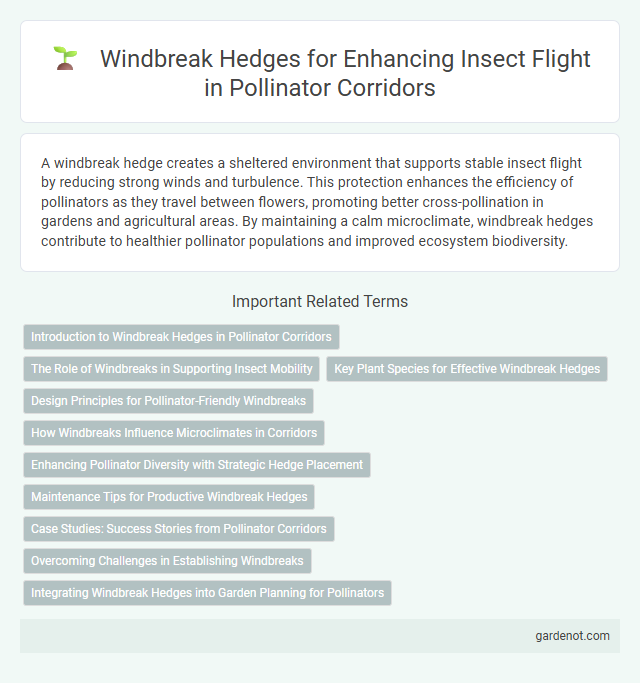A windbreak hedge creates a sheltered environment that supports stable insect flight by reducing strong winds and turbulence. This protection enhances the efficiency of pollinators as they travel between flowers, promoting better cross-pollination in gardens and agricultural areas. By maintaining a calm microclimate, windbreak hedges contribute to healthier pollinator populations and improved ecosystem biodiversity.
Introduction to Windbreak Hedges in Pollinator Corridors
Windbreak hedges serve as essential structures in pollinator corridors, reducing wind speed to facilitate easier insect flight and enhance pollination efficiency. These hedges create microclimates that protect pollinators from harsh winds, increasing their foraging activity and improving plant-pollinator interactions. Incorporating native shrub and flowering plant species in windbreak hedges optimizes habitat quality and supports diverse pollinator populations.
The Role of Windbreaks in Supporting Insect Mobility
Windbreak hedges reduce wind speed, creating calmer microclimates that enhance insect flight efficiency and energy conservation. These vegetative barriers support pollinator corridors by facilitating safer and more effective movement of bees, butterflies, and other beneficial insects between floral resources. Research indicates that strategically planted hedges increase pollinator visitation rates and contribute to biodiversity in agricultural landscapes.
Key Plant Species for Effective Windbreak Hedges
Effective windbreak hedges for pollinator corridors include native flowering shrubs such as Ceanothus, Mahonia, and Salix species, which provide essential nectar and pollen resources. Incorporating diverse plant species like Sambucus nigra and Rubus allegheniensis enhances structural complexity and supports a wide range of beneficial insects. Selecting key plants with dense foliage and staggered bloom periods ensures continuous shelter and food supply for insect flight and pollination activities.
Design Principles for Pollinator-Friendly Windbreaks
Windbreak hedges designed for pollinator corridors prioritize plant species diversity, structural layering, and continuous flowering periods to facilitate optimal insect flight and habitat connectivity. Incorporating native shrubs and flowering plants with varying heights enhances shelter and feeding opportunities, supporting both nectar sources and nesting sites. Proper spacing and orientation aligned with prevailing winds reduce turbulence, creating safe flight paths for pollinators such as bees, butterflies, and hoverflies.
How Windbreaks Influence Microclimates in Corridors
Windbreak hedges in pollinator corridors alter microclimates by reducing wind speed, which stabilizes temperature and humidity levels crucial for insect flight and foraging activity. By creating sheltered zones, these hedges increase pollinator efficiency and diversity, supporting local biodiversity and crop pollination. The moderated microclimate also minimizes stress on pollinator species, enhancing corridor functionality as continuous habitats.
Enhancing Pollinator Diversity with Strategic Hedge Placement
Strategic placement of windbreak hedges creates sheltered microhabitats that facilitate insect flight, boosting pollinator diversity in agricultural and natural landscapes. These hedges reduce wind speed, enabling easier navigation and foraging for bees, butterflies, and other beneficial insects. Incorporating native flowering shrubs in windbreaks further enhances habitat quality and resource availability for diverse pollinator communities.
Maintenance Tips for Productive Windbreak Hedges
Regular pruning of windbreak hedges promotes dense foliage growth essential for supporting insect flight and pollinator activity. Removing dead or diseased branches prevents pest infestations and ensures the hedge remains a healthy corridor for pollinators. Applying organic mulch helps retain soil moisture and provides nutrients, enhancing the hedge's vigor and effectiveness as an insect flight barrier.
Case Studies: Success Stories from Pollinator Corridors
Windbreak hedges in pollinator corridors have demonstrated significant improvements in insect flight efficiency by reducing wind turbulence and providing essential shelter for pollinators like bees and butterflies. Case studies from regions such as the Midwest USA show increased pollination rates and crop yields in farms adjacent to strategically planted windbreak hedges consisting of native shrubs and trees. Research from the UK's Sussex area reveals that these hedges support higher insect biodiversity, promoting ecological balance and enhancing crop resilience.
Overcoming Challenges in Establishing Windbreaks
Establishing windbreak hedges for insect flight requires selecting native, dense plant species that provide continuous shelter and nectar sources to support pollinator movement. Addressing issues like soil erosion, pest resistance, and microclimate variation enhances hedge durability and effectiveness in creating wind protection corridors. Proper site assessment and adaptive management techniques ensure successful establishment and long-term functionality of pollinator-friendly windbreaks.
Integrating Windbreak Hedges into Garden Planning for Pollinators
Integrating windbreak hedges into garden planning creates sheltered pathways that enhance insect flight efficiency and protect pollinators from harsh winds. Selecting native, flowering shrubs in dense arrangements provides essential nectar sources and habitat, promoting biodiversity within pollinator corridors. Strategic placement of these hedges near crop fields or wildflower patches optimizes pollinator movement and supports ecosystem resilience.
Windbreak hedge for insect flight Infographic

 gardenot.com
gardenot.com